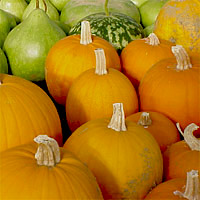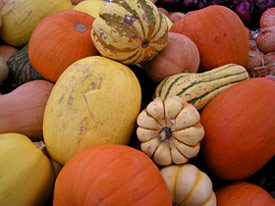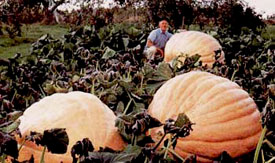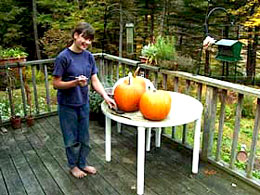Edible of the Month: Pumpkins
By: Charlie Nardozzi
 Ripe pumpkins are one of the sure signs of fall. For painting and carving, it’s best to choose a variety with smooth skin.
Ripe pumpkins are one of the sure signs of fall. For painting and carving, it’s best to choose a variety with smooth skin.
No other vegetable says ‘fall’ like the pumpkin. This Native American fruit can range in size from a few ounces to more than 1000 pounds, depending on the variety. And pumpkins aren’t necessarily orange. You can grow white and even blue pumpkins! Some varieties are perfect for making jack-o-lanterns and painting. Others are better suited for making pies and cooking. Some varieties are loaded with seeds that have thin hulls (often described as hulless), making them perfect for roasting into a healthy snack. Some varieties were bred for giant pumpkin competitions, while others are small and cute, and perfect for holiday decorating.
Whatever pumpkin variety you choose to grow, chances are you’ll have some success with this easy-to-grow squash-family vine. I even had a self-sown pumpkin growing out of a wall near my asphalt driveway this summer. Curious as to what would happen, I let it grow and it produced a 10-pound fruit! So skip the farm stand next year and plant a pumpkin patch for you and your kids (or grandkids). Kids love to adopt the pumpkin fruits and you can have them carve their names on the young fruits and watch the carving expand with the pumpkin as it matures.
Planning
Choose pumpkin varieties based on their usage. Since these plants vine vigorously, find a location in full sun with fertile, well-drained soil and lots of room for them to roam. A few plants will produce enough pumpkins for most families.
Here are some of the best varieties to try. Days to maturity are listed for each.
- ‘Baby Bear’ (105 days). This 1- to 2-pound mini-pumpkin with deep orange skin is good for pies. It has hulless (thin hulls) seeds that are great for roasting. It produces an average of eight fruits per plant.
- ‘Baby Boo’ (90 days). This white mini-pumpkin with yellow flesh grows 2 to 3 inches in diameter and averages eight to ten fruits per plant. It’s best harvested before the skin turns pale yellow.
- ‘Big Max’ (120 days). This large, pink-orange pumpkin can grow up to 100 pounds, but averages only two to three fruits per plant. It’s great for carving and making pies.
 Pumpkins are in the squash family. While we traditionally use the orange pumpkin for carving and pies, many winter squash work just as well.
Pumpkins are in the squash family. While we traditionally use the orange pumpkin for carving and pies, many winter squash work just as well.
- ‘Connecticut Field’ (110 days). A large, 15- to 30-pound, slightly ribbed, light orange fruit that’s good for carving. It averages two to three fruits per plant.
- ‘Dill’s Atlantic Giant’ (120 days). This is the big one! This variety holds the world record, growing to more than 1500 pounds. It needs fertile soil, lots of space, and special growing conditions to produce the award-winning fruits. (See article below). It produces one or two pink-orange fruits per plant.
- ‘Howden’ (115 days). This deep orange fruit has defined ribs and a strong handle (stem) that make it good for carving. It produces two or three 20-to 30-pound fruits per vine.
- ‘Rouge Vif D’etamps’ (115 days). A French heirloom with a flat shape, scarlet skin, and mildly sweet orange flesh, it averages two 10- to 15-pound fruits per plant.
- ‘Long Island Cheese’ (108 days). This unusual, flat, ribbed, tan fruit with deep orange flesh resembles a wheel of cheese. It’s a good pie pumpkin and averages two 6- to 10-pound fruits per plant.
- ‘Lumina’ (85 days). This unique, smooth, white-skinned pumpkin has orange flesh. It’s good for painting and carving and averages three or four 10-pound fruits per plant.
- ‘Orange Smoothie Hybrid’ (95 days). These smooth, bright orange, 6- to 9-pound fruits are perfect for painting. This variety averages three to four fruits per plant.
- ‘Small Sugar’ (100 days). This orange heirloom is great for pies and canning. It produces three or four 5- to 8-pound fruits per plant.
- ‘Queensland Blue’ (100 days). A pumpkin of a different color, this Australian heirloom has bluish-green skin and averages two or three deeply ribbed, 6- to 10-pound fruits per vine.
 If you’re ambitious, you can grow these ‘Atlantic Giant’ pumpkins. The world record holder is over 1600 pounds. That’s a lot of pies!
If you’re ambitious, you can grow these ‘Atlantic Giant’ pumpkins. The world record holder is over 1600 pounds. That’s a lot of pies!
Planting
Pumpkins and all winter squash grow best in full sun in regions with warm, moderately moist summers. They like high fertility, so amend the soil with a 2- to 3-inch layer of compost before planting. In cool-summer areas you may want to start plants indoors 4 weeks before your last frost date to get a jump on the season. Also, in cool areas lay black plastic mulch over the planting bed a few weeks before the last frost date. Poke holes in the plastic to plant the pumpkin seeds or plants.
In all areas, sow seeds when the soil has warmed to 60 degrees F. Sow seeds 2 to 4 feet apart in rows 5 to 8 feet apart. Or plant 5 to 7 seeds in hills spaced 4 feet apart.
Care
Pumpkins need water to keep them growing strong. Apply 1 to 2 inches of water per week — more during dry periods. While pumpkin vines will eventually fill a large area, when young they need to be weeded regularly to give them a strong start. Cultivate lightly around plants with a hoe. Avoid disturbing the pumpkins’ shallow roots. Unless you’re growing them on black plastic, mulch plants with straw once five leaves form.

In addition to applying compost before planting, side-dress pumpkins once the vines start running with a high nitrogen fertilizer, such as alfalfa meal.
If you want to form just a few large fruits per vine, pinch off pumpkin blossoms and small fruits that form after two or three early fruit have set. The plants will send more energy into the remaining fruits and they will grow larger. Plus, in cool summer areas these later fruits wouldn’t have time to mature before frost anyway.
Some gardeners worry that their pumpkin plants will cross-pollinate with other squash plants. Although pumpkins can cross-pollinate with other squash-family crops, it’s not a concern unless you try to save the seeds from this year’s crop and sow them next year. If you do save and plant the seeds next year it’s likely you’ll get some odd-looking fruits in the pumpkin patch.
Pumpkins have few insect and disease problems. Squash vine borers sometimes tunnel into pumpkin vines, opening the vines to disease and rotting. Cover young plants with a floating row cover to prevent the adult fly from laying eggs in spring. Remove larvae in the stems with a sharp knife or inject Bacillus thuriengensis (B.t.) into the stems to kill the larvae. Squash bugs can feed on leaves, but are only a problem if they occur early in the season. Spray a botanical pesticide to control them. To keep diseases at bay, leave lots of space between plants, keep the patch weed free, and select disease-resistant varieties.
Harvest
Leave pumpkins on the vine until they size up and turn the appropriate skin color for that variety. Pumpkins will continue to mature after picking, but color up best if left on the vine for as long as possible. Harvest all your pumpkins before the first hard frost. To harvest, cut the stems 2 inches above the fruits with a sharp knife. Carefully remove the fruits, taking care not to nick the skin. Damaged fruits won’t last long in storage. Wipe the skin clean with a mild bleach solution to kill any disease spores. To help pumpkins last longer, cure the fruits by placing them in an 80- to 85-degree F, humid room for two weeks. Store in a 50- to 55-degree F, dark location. Most pumpkins can be stored for 2 to 3 months under proper conditions.
Source: http://www.garden.org/articles/articles.php?q=show&id=3888
//



Leave a Reply
You must be logged in to post a comment.